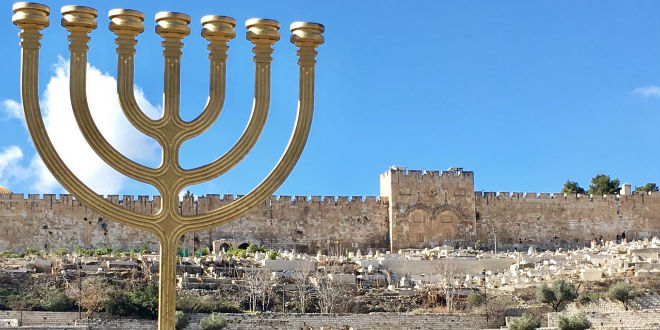
PART 1
This is the first part of a multiple parts posting to take the time to explain the symbolism of the menorah for Latter-day Saints.
H G R R G H H = Heifer, G = Goat, R = Ram
The menorah symbol is actually a representation of the Tree of Life. It really does look like a tree. We know from the Book of Mormon that the Tree of Life represents the Savior Jesus Christ (see 1 Nephi 11:21-22). The symbol is derived from the ancient animal sacrifices of a heifer, goat, and ram. As each animal is laid down to be sacrificed, it is cut in the midst or middle into two pieces (see Gen. 15:9-10). Hence, the semi-circle pattern of each branch of the menorah is made up of cutting the heifer, goat and ram down the middle to create two halves or branches of the menorah. The middle candlestick is the Lord himself or His Spirit that cuts the animals into the two pieces or branches (see Gen. 15:17).
Anciently all animal sacrifices were symbols of the ultimate sacrifice of Jesus Christ, the Son of God (see Moses 5:6-8). Hence, the menorah is literally a perfect symbol of the Savior pointing to His atoning sacrifice, even the Tree of Life.
We have a golden menorah placed among our Nativities that serves as a reminder that we celebrate Jesus Christ’s life at Christmas, not just His birth.
While staying in New York City, several years ago, we walked to a synagogue and asked the Rabbi what he thought of our interpretation of the menorah being a symbol of the Tree of Life. There are so many representations of the Tree of Life in all cultures, we were curious about what he might say. He was polite and thought our idea was interesting, but he, himself had never seen it that way.
One day, we know the Jews will come to realize who their Savior really is and they too will celebrate the salvation He offers all.
Be sure to look at these additional posts: part 2, part 3, part 4, part 5 about the symbolism of the menorah.
(Special thanks to Lee Donaldson-CES instructor-for these insights)

Thank you for the explanation. Is there a significance to the type of animals that were sacrificed? What about the number of candles? In fact, when did the menorah first come into use and why? You give me a few answers and all I give you is more questions!
The menorah symbol appears to have come into use in the days of Abraham from the Genesis references that were provided in the original posting. Again its shape and form are a representation of the animal sacrifices which points to Christ and His atonement. The formation of the branches from dividing the various animal sacrifices forms the branches of a tree and in this case the Tree of Life. So you could argue this symbol has been around since the beginning because the Tree of Life is mentioned in the beginning in the Garden of Eden (Moses 3:9). So the real answer, we don’t know, except I believe it has been around a long time.
The number 7 stands for perfect or complete, meaning Christ’s life and atonement are perfect and complete to save all of God’s children.
The significance of the type of animals will be discussed in a future part since there is a lot to be said about each animal sacrifice and what is represents. Typically these postings are done on Sundays. I hope that answers your questions.
The ancient temple had seven lights burning which would produce seven shadows. These represent the seven levels of understanding in the temple worship. It is true that it represents the tree of life who is the messiah but it was a pattern to see the world with as it was in the garden of eden. Originally it was made of gold and burned continually in the temple before the alter. Every person and object in the temple would therefore have seven shadows against the walls. Jesus said let your light so shine before men. Also John saw the candlestick in his revelation. The Menorah represents the pattern of thought we should use to read and ponder the scriptures. To study with seven eyes is a Hebrewism meaning search the scriptures.
You do realize that you have not described a menorah but just a candle holder. A menorah has 4 holders on each side of a lead candle. So it totals 9 candles in holders.
What you are describing is the Maccabean Menorah that is used for Hanukkah. The candlestick in this article is the one used by the ancient Israelites.
Was there not another group of animals sacrificed eg fouls? and were they not actually slaughtered on the alter. I’d love to understand more regarding the places where the animal was killed as your article describes.
Very interesting subject. Thanks
Many different types of animals, including fowl, could be purchased for sacrifice. They all represented a sin of some kind you wished the priest to burn on your behalf. The larger animals, however, were raised specifically for the priest to sacrifice, in the name of Jesus Christ, during the appropriate holy days.
Fantastic content! Your insights are enlightening. I appreciate the clarity of your writing. Looking forward to implementing these strategies. Excited for more valuable posts from you!